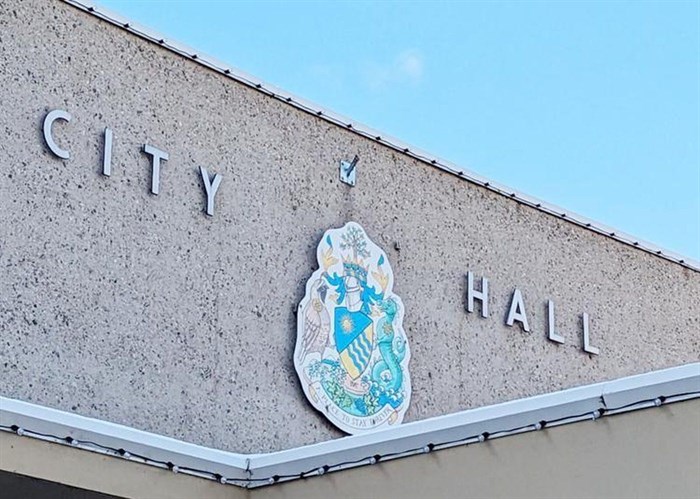Anger over $11M lake-to-lake bike lanes in Penticton dominates public meeting
City of Penticton staff and Mayor Julius Bloomfield likely expected the controversy — but it didn’t take long for anger over the lake-to-lake bike lanes to dominate last week's public meeting on a proposed infrastructure levy.
About 120 residents packed into council chambers for a presentation on the proposed levy, which would dedicate 4.25 per cent of annual property tax revenue to a new infrastructure reserve fund, increasing by one per cent annually to nine per cent by 2030.
Instead of the current fixed contribution of $3.2 million a year, the levy would scale with tax revenue, helping the city address aging infrastructure such as fire halls, arenas, and city buildings.
But after a 30-minute staff presentation, the Q&A period quickly turned heated, with many residents venting frustration over the $11-million lake-to-lake bike lane project.
Though staff asked attendees to stay on topic, public anger centred on the bike lanes — especially costs, safety concerns, and what some perceived as a lack of community consultation.
One man said he attended every public hearing about the bike lanes and felt ignored. “There’s a disconnect between city staff, council, and the people,” he said.
Another resident said she supports replacing the fire hall but was upset that millions were spent on bike lanes first. “I live on the lake. I pay high taxes. I’m nervous to drive. My mom can’t get out of her driveway. This is ridiculous,” she said. “Don’t say we had a choice — we didn’t.”
Kristen Dixon, General Manager of Infrastructure, and Angela Campbell, General Manager of Corporate Services, responded by explaining that most funding for the bike lanes came from senior government grants, which were not eligible for other infrastructure projects.
“It might not be a project you like, but that money couldn’t have been used for a fire hall,” said Campbell. “Some of it comes from taxes we already pay provincially and federally, so it is partially local, but those grants are specific.”
She added that the city has been transparent, referencing a dedicated webpage explaining the bike lane project and funding sources.
Communications Director Anna Melnick asked residents to hold bike lane questions until after the meeting, but discussion continued to drift.
One man referenced a future capital projects list that included more bike lanes, estimated at $6.7 million, calling it the city’s “top priority.”
Dixon clarified that the list is not ranked and comes from the city’s Master Transportation Plan, developed through public input. “When it comes time to fund those projects, council will decide which go forward,” she said.
Another woman raised safety concerns about the road design near the Sikh Temple on South Main. “Members are terrified pulling in and out. In an emergency, precious seconds could be lost. Why was this design chosen?”
Some asked why Mayor Julius Bloomfield and councillor-elect Shannon Stewart were the only two councillors in attendance.
Despite city staff’s attempts to redirect the conversation, it was clear the bike lane issue remains a sore point for many residents. Several stayed afterward to speak with staff one-on-one about both the levy and their ongoing concerns.
Though intended as a discussion about a long-term infrastructure funding strategy, the meeting revealed how deeply the bike lane project continues to divide the community — and how difficult it may be for city leaders to regain public trust when it comes to major capital spending decisions.
To ensure funds are available to replace and upgrade failing city-owned infrastructure, the City of Penticton is proposing a new infrastructure levy. Within five years, this levy would direct nine per cent of property tax revenue toward infrastructure investment.
At the well-attended public meeting, with about 120 residents in council chambers, senior city staff explained the rationale for the levy, its necessity, and how it would secure long-term funding for critical infrastructure.
With 2026 budget planning approaching, the city is reconsidering its longstanding policy of contributing a flat $3.2 million annually to infrastructure. Instead, the new plan would allocate 4.25 per cent of total property tax revenue to infrastructure in 2026.
This contribution would rise by one per cent annually, reaching nine per cent by 2030.
Mayor Julius Bloomfield and councillor-elect Shannon Stewart, who will be sworn in Tuesday following a recent byelection, joined senior staff at the session. No other council members were present.
“Tonight we’re here to provide information about the proposed infrastructure levy,” said Chief Administrative Officer Andrew Haddad. “We’re entering an era of infrastructure reinvestment that we, as a city, must take seriously. This is the result of years of planning.”
The session was intended to inform residents, gather feedback, and reinforce council’s commitment to transparency and public engagement.
Growing needs and shrinking reserves
Angela Campbell, General Manager of Corporate Services, said the city’s three major reserve funds — asset sustainability, capital, and equipment replacement — had a combined balance of $20 million at the end of 2024.
That total is expected to shrink to $14.3 million by 2029, not including $160 million in currently unfunded capital projects.
“Construction and related costs far exceed historical contributions,” said Campbell.
A 2023 review of best practices in other municipalities confirmed that Penticton’s infrastructure funding is significantly under-supported.
Currently, the city relies on $3.2 million annually from government dividends, gas tax funds, and equipment replacement contributions.
But with rising construction costs and aging infrastructure, these sources fall far short.
Over the past five years, Penticton has spent an average of $12.6 million annually on capital projects, with only $7 million of that dedicated to asset renewal. The target life cycle investment should be $13.6 million per year.
“This underfunding increases the risk of asset failure, costly emergency repairs, and service disruptions,” said Campbell. “The levy would allow us to build reserves gradually and avoid sudden tax increases in the future.”
A predictable, sustainable model
Funds raised through the levy would be placed in the asset sustainability reserve, which is restricted to infrastructure replacement — not operating costs. This model would scale with the city’s growth and offer a more consistent approach to long-term planning.
“The levy is not a new tax or an increase in taxes,” Campbell emphasized. “It simply changes how infrastructure contributions are calculated — from a fixed amount to a percentage of tax revenue.”
The city currently contributes about $1.9 million annually to asset replacement — well below the $4.5 million (or 9 per cent of taxes) needed. The proposed levy starting at 4.25 per cent in 2026 would bridge this $2.6 million gap by 2030.
Council would maintain full control over how reserve funds are used, with all capital projects requiring council approval. Annual increases to the levy would be reviewed during each budget cycle, ensuring flexibility.
“Adopting this approach now, in the face of rising construction inflation and major projects on the horizon, is key,” said Campbell. “Delaying investments only compounds the funding shortfall and increases future taxpayer burdens.”
Much of Penticton’s infrastructure — including arenas, fire halls, and city hall — was built in the 1950s to 1970s and is reaching the end of its usable life. Replacing these facilities will be costly but necessary.
“Looking ahead 20 to 25 years, we expect to see another 15,000 to 20,000 residents. We need to act now to prepare,” said Haddad.
Dixo said the city completed an asset review in 2023 that estimated total replacement costs for city-owned infrastructure at $1.4 billion — a figure likely to rise with inflation.
The city’s general fund infrastructure assets total nearly $600 million, including transportation ($200M), facilities ($347M), parks ($35M), and fleet and equipment ($16M). These assets are separate from utilities, which are funded by user fees and respective reserves.
Dixon emphasized that maintaining current service levels would require investing $13.6 million annually or saving accordingly. An asset management plan initiated in 2019 identified four top infrastructure priorities:
• Replacement of the main and satellite fire halls
• New twin-rink arena to replace McLaren and Memorial Arenas
• An arts and culture centre
• Replace or upgrade city hall
A new fire hall alone is projected to cost $40 million, while the new arena complex could run between $70 to 80 million.
“The levy would only fund replacements of existing infrastructure,” said Dixon. “Expansions or new assets would need separate funding.”
Balancing taxpayer impact
Dixon acknowledged that while most residents don’t want higher taxes or user fees, there is broad support for maintaining and expanding services — rather than reducing them.
Other municipalities, including West Kelowna, Kelowna, and Vernon, have recently adopted similar levies to address their own infrastructure challenges.
Campbell explained that the city had previously contributed $300,000 annually to infrastructure reserves, but that amount hasn’t kept pace with construction costs. For example, two new arenas estimated at $20 million in 2015 now cost nearly $80 million.
“We’ve been putting money aside, but the speed at which construction costs have risen has outstripped what we can afford,” she said.
During COVID in 2022, the city deferred taxes over a three-year period, requiring an additional three per cent from taxpayers in 2023, 2024 and 2025. Council opted not to introduce further tax hikes during that period.
In response to a resident’s question about why staff make capital recommendations, Campbell clarified that while staff prioritize projects based on need, council always has the final say on what moves forward and how it’s funded.
Public feedback sessions like Thursday’s are part of the budget process, and input is shared directly with council.
Council will consider the proposed infrastructure levy at its Sept. 16 meeting. If approved, it will be further discussed during budget deliberations in mid-November.
— This story was originally published by the Penticton Herald




